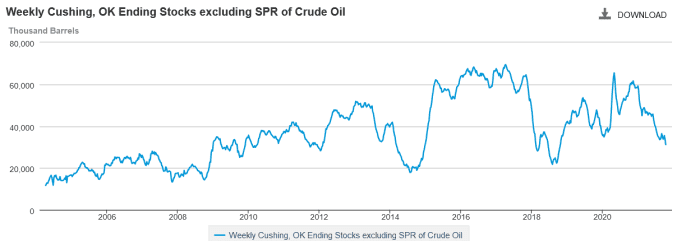This post was originally published on this site
Backwardation in the futures contracts for U.S. benchmark West Texas Intermediate crude oil implies a shortage of supplies at the Cushing, Okla. delivery hub for the contracts, an analyst told MarketWatch on Friday.
The price spread between the front-month December WTI contract
CLZ21,
CL.1,
versus the WTI contract for December 2022
CLZ22,
has reached levels that haven’t been seen for years, said Phil Flynn, senior market analyst at The Price Futures Group. Prices for December crude of this year are going higher, while prices for contracts further out are “lagging.”
That’s a condition known as backwardation — the front-month contracts are trading higher than prices for later months.
On Friday, front-month December WTI crude futures rose $1.26, or 1.5%, to settle at $83.76 a barrel on the New York Mercantile Exchange. The December WTI contract for 2022, meanwhile, settled at just $72.06 a barrel.
Read: U.S. oil futures score the longest weekly winning streak on record
“Backwardation in WTI oil futures indicates that oil supplies at the all-important Cushing, Okla. delivery point are “basically empty.’”
That backwardation tells us that oil supplies at the all-important Cushing, Okla. delivery point for the WTI futures contract are “basically empty” because people are buying as much crude in the front end of the curve as they can get their hands on,” Flynn said. Meanwhile, the back end of the curve is under pressure given the assumption that “by next year, those supplies might refill the empty caverns.”

Source: Energy Information Administration
“This is the exact opposite of what was happening during the depths of the COVID demand crush, when WTI oil prices fell below zero” in April 2020, said Flynn.
For the week ended Oct. 15, Cushing, Okla. ending stocks, excluding the Strategic Petroleum Reserve, was at 31.2 million barrels — the lowest since October 2018, according to the Energy Information Administration.
An EIA report from late September said Cushing oil inventories were down more than 40% from the beginning of this year.

